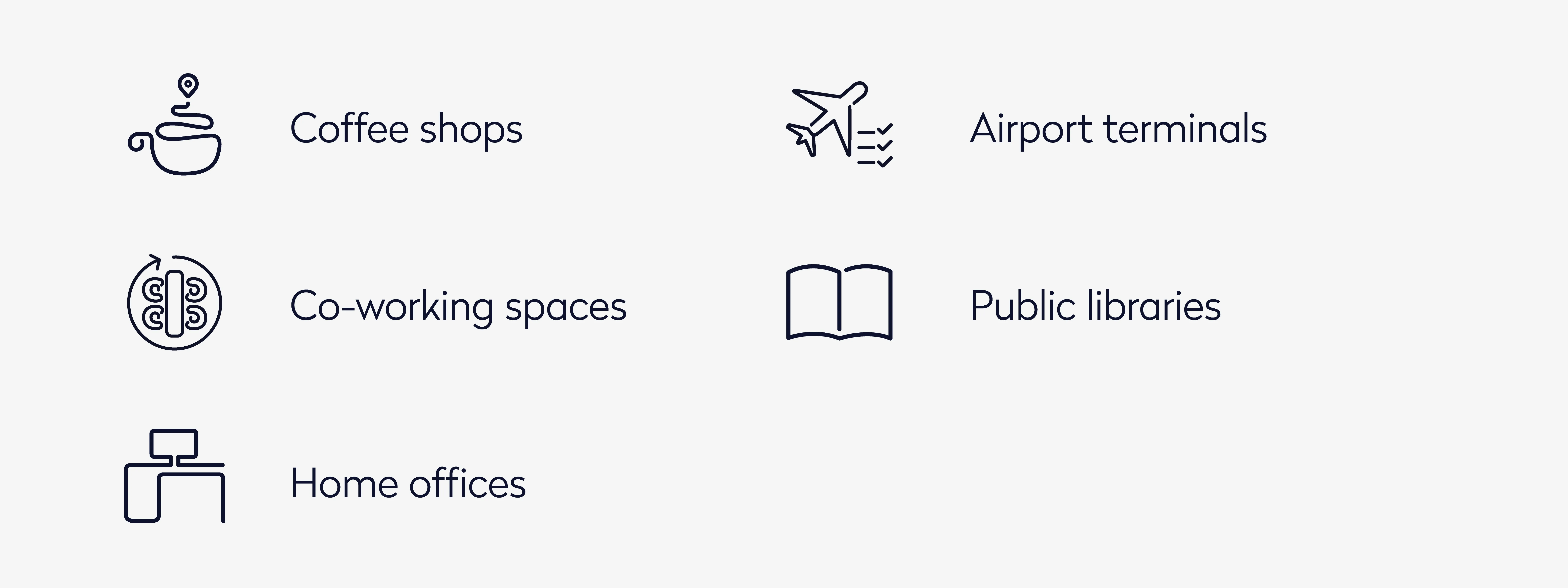
Key takeaways
- Alternative workplaces prioritize the worker over the physical workplace. Flexibility in location and environment empowers employees to work where they’re most productive.
- The concept has evolved from location-based alternatives to experience-driven choices. Modern definitions include how the environment supports productivity, not just where the work happens.
- Technology has made alternative workplaces a sustainable, long-term strategy. Cloud tools, mobile devices, and high-speed internet have enabled remote work, coworking, and flexible arrangements to become standard.
In 1998, the Harvard Business Review published a futuristic article, The Alternative Workplace: Changing Where and How People Work. While it was a new and exciting concept back then, in 2023, it isn’t too groundbreaking. If anything, it’s the new normal.
It describes remote work and a growing detachment from the traditional workplace. That said, it’s a prophetic-sounding piece from more than 20 years ago that predicted the alternative workplace we’re seeing today.
Indeed, we have moved from an era in which people actively seek connections with one another to an era in which people decide when and where to disconnect — electronically and socially. Current organizations pursuing alternative workplace initiatives — particularly those with home office arrangements — must be mindful of that paradox.
The rise of the alternative workplace has been a long time coming, as evidenced by the above passage. The global pandemic was just the latest catalyst driving alternative solutions into the spotlight. Today, alternative workplace strategies have taken center stage and are fulfilling the vision first adopted in 1998.
Alternative workplace definition
What is an alternative workplace? It’s a fair question and readily answered by many of the work trends we’re familiar with today. Telecommuting and remote work. Coworking. These paint a picture of the alternative workplace.

In 1998, “alternative workplace” focused more specifically on alternatives to working in an office. Today, the definition focuses more on where employees work and how that environment supports them — from a well-furnished coworking space to the free Wi-Fi at a local coffee shop.
Key elements of the alternative workplace
Alternative workplaces are highly diverse because they can encompass just about any environment that supports work. So long as it supports your ability to work and it’s outside of the “home base” workplace, it falls under the guise of an alternative workplace.
A coworking space might have an office feel and all the amenities of a traditional workplace. Still, it’s an alternative workplace because professionals from other companies and career paths surround you. Your home office is an alternative workplace. Even an airport lounge is an alternative workplace — even if you only work there for 45 minutes before a flight.
Are you sitting in an alternative workspace right now? Take stock of the environment and see if it offers these essential elements:
- Are you using your own technology?
- Do you have control over your seating?
- Do you have control over your work habits?
- Is the environment conducive to your work?
- Are there people other than coworkers around you?

Most coffee shops, coworking spaces, home offices, breakout spaces, airport terminals, public libraries, and similar facilities fit the bill. But the alternative workplace isn’t only shaped by physical surroundings — more important is how it empowers employees.
Emphasize the worker instead of the workplace
Alternative workspaces are defined by the freedoms they afford workers. These workplaces sever the tie between work and any one single place, which also means they give employees the power to self-govern. When allowed to choose their own venue and work in their own way, many workers seize the opportunity to do their best work in their best manner.

It’s not surprising that many companies invested in alternative workplace strategies over the past two decades — even pre-pandemic. Unlinking work from the workplace and instead hitching work to the worker brings untold flexibility to the concept of what a workplace is. Hence, the current rise in alternative workplaces.
If an employee can produce 100% regardless of whether they work at a desk, in an office, or an easy chair at home, does it matter where they work? Most likely not. What if they could accomplish 120% from their easy chair? It’s a very real driver behind the hype in alternative workplaces.
Alternative workplace concepts come down to an investment in work and the worker, instead of the workplace. So long as they can do the job, who’s to stop employees from doing it in a place that’s comfortable, familiar, and supportive of their personal work habits? It’s a trade many employers willingly make for bolstered productivity, improved culture, and employee satisfaction.
Alternatives are part of today’s modern workplace
“This is not a fad” is a simple but striking sentence in the groundbreaking 1998 Harvard Business Review article. Indeed, it’s not, especially to have survived over 20 years and become the foundation for the adaptive workplace solutions we see today.
The rise of the internet, cloud applications, and better computing technology have all made alternative workplaces viable solutions as companies navigate the modern workplace.
Remote work, flex scheduling, hoteling, experiential workspaces, and coworking are all alternative forms of work, but they’re only part of the greater alternative workplace employees rely on today.
Frequently asked questions
Any location outside a company’s primary office that supports productive work — such as a home office, coworking space, coffee shop, or airport lounge — can be considered an alternative workplace.
Advances in technology, cultural shifts toward flexibility, and the need for adaptable work environments — especially during and after the pandemic — have made them a practical and attractive option.
They boost productivity, improve work-life balance, reduce real estate costs, and give employees the autonomy to choose environments where they can perform at their best.








